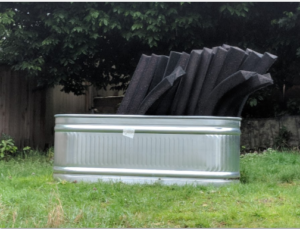To quickly give someone a look at the state of computer vision, there is a fun demo on the Google Cloud Vision site. You just drag a photo onto it, and you can learn what the AI sees along a few key vectors. After seeing it easily recognize and classify my photos of poodles and cherry trees, I started playing with photos I’ve taken that are actually tricky for humans to parse. Playing that type of game helps define the limits of what’s possible today, and things that happen at the boundaries suggest very interesting possibilities for tomorrow. I found that Cloud Vision today can touch on the subjective experiences of viewing art, and also do a good job sorting out things that are merely odd as opposed to things truly expressing artistic intent.
In this photo I laid a Christmas wreath on top of a pizza box that had an illustration of Sasquatch wearing a Seattle Sonics headband.

Cloud Vision nails the Christmas decoration aspect of the photo, but I was delighted to see that it indicated that there was about a 50% chance that this was some kind of art.

I’ll admit that it’s not very good art, but when I put together my little tableau, I was trying to capture something about the quirkiness of Seattle with an artifact I could use to communicate to people not from here. Personally, I’d set the odds of it being granted the status of “art” at much less than 50% so I felt Cloud Vision’s assessment was generous.
After that discovery through experimentation, I figured I should establish a control before doing more tests. Below is a photo from the Microsoft art collection. It’s a graffiti covered piece of the Berlin Wall on display at the Microsoft Conference Center in Redmond.

It’s been about 40 years since anyone has questioned whether or not graffiti art is worthy of gallery status—a sensibility Cloud Vision is certainly aware of based on how it labeled this piece.

Below is a photo I took just because I was thinking, “I sure have some odd stuff in my yard.” The metal thing is a watering trough for livestock that is destined to be a planter. The black things sticking up out of it are foam gutter inserts that keep leaves from blocking your gutters but let water flow through.

As a thing, it could be a Philistine’s parody of modern art (it bears a slight resemblance to Typewriter Eraser, Scale X by Claes Oldenburg) but not even the rubes would mistake it for actual art. Although I was a little surprised Cloud Vision couldn’t identify a watering trough, it did offer some pretty valid labels.

Mostly, I was heartened that it didn’t try to slap the label “art” on it.
